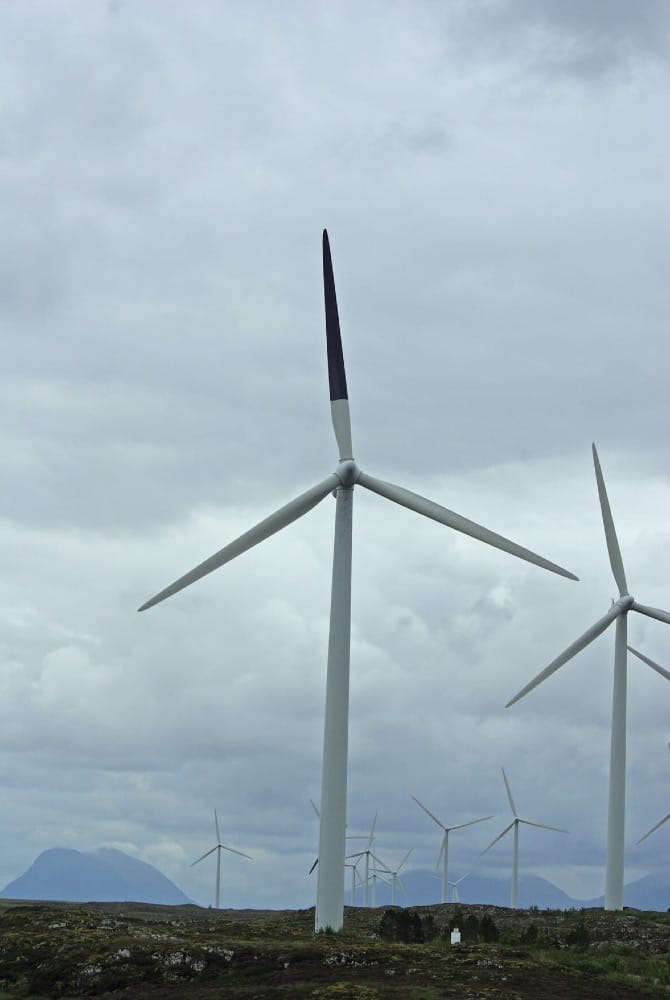Do painted wind turbine blades reduce bird fatalities?
Painting wind turbine blades in a different color has shown promising results for reducing bird fatalities.

With increasing numbers of onshore and offshore wind turbines, scientists continually examine new ways to reduce bird and bat collisions with spinning turbine blades. Methods for lowering bird and bat collisions, including blanket curtailment, smart curtailment, and acoustic deterrents, have had varying degrees of success across studies.
One novel method with some potential to reduce fatalities is to paint one or more turbine blades a different color than standard white. Painting blades would theoretically improve blade visibility by decreasing motion smear while the blades are spinning and has shown effectiveness in reducing fatalities by as much as 70% in a study by Roel May and colleagues. While the initial research is promising, replication is needed to examine the technique's effectiveness in other locations with other species. Unlike curtailing turbines, blade painting does not reduce energy production, is low-cost, and can be built into the manufacturing process prior to turbine operations.
Blade painting to reduce bird mortality
Effective measures that reduce bird mortality at wind facilities may reduce fatalities at existing sites and enable development at new sites that would previously have been too high a risk to birds. Most bird fatalities occur through collisions with rotating turbine blades where, presumably, birds do not perceive the blade obstructions ahead. Improving the number and type of visual cues may enhance the visibility of the moving blades and allow birds to avoid collisions.
Experimental laboratory studies have shown blade painting may help to decrease motion smear and improve visibility, but it wasn't known whether this would translate to fewer bird fatalities. The research question tested at the Smøla wind facility in Norway in the May study was whether turbines with one painted blade would result in fewer bird fatalities than those with unpainted blades.
Blade painting study methods
In the May study, researchers tested the effectiveness of painted blades at the Smøla Wind Power Plant, where four treatment turbines were painted black, and four nearby control turbines were unpainted. At these eight turbines, researchers used dogs to search for carcasses so fatalities could be compared between painted and unpainted turbines. Control turbines were close to the painted turbines, so they were as similar as possible spatially.

Blade painting study findings
Across all bird species, there was a 71.9% reduction in bird fatalities at the painted treatment turbines compared to the unpainted control turbines. There was considerable annual and seasonal variation in fatalities. There were decreases in fatalities at painted turbines in the spring and fall but more fatalities at painted turbines during the summer. There were also no findings suggesting that birds were forced into neighboring turbines after evading the turbines with painted blades despite fatality rates increasing at unpainted turbines following blade painting.

All species [except Hooded crow (Corvus cornix) and unidentified Passerine species] showed fewer fatalities at the painted turbines than at the unpainted turbines. Blade painting seemed to be especially effective at reducing raptor fatalities. Prior to blade painting, six white-tailed eagles (Haliaeetus albicilla) had been found at the to-be-painted turbines; after blade painting, no white-tailed eagle fatalities were found. This finding is notable because raptors are known to be vulnerable to wind turbine collisions, primarily because of soaring and foraging behavior at rotor-swept height.
Limitations of the Smøla painted blade study
A major limitation of the May study is it is unknown whether fatality reductions will occur in other locations with other species. This uncertainty necessitates additional validation studies to see if similar findings occur under different conditions in new locations. Only four unpainted and four painted turbines were studied, which limits the conclusions that can be drawn from this study.
Additional Research
There is an additional study with collaborators PacifiCorp, the Renewable Energy Wildlife Institute, the United States Geological Survey, and others to examine the effects of blade painting on eagles, non-eagle birds, and bats. This study, being done at the Glenrock/Rolling Hills wind facility in Wyoming, will validate if the blade painting study done in Smøla can be replicated in a different location with different species. There will be 36 painted treatment turbines and an equal number of unpainted control turbines. It's also hypothesized that bats will be unaffected by blade painting, and there will be no difference in fatalities between painted and unpainted turbines.
Other research questions that need further study include blade painting with ultraviolet paint or painting with a different color besides black. It's also unknown if the public will tolerate painted turbine blades because they will be more visible than unpainted turbines. Finally, the effects of painting on blade integrity over time are poorly understood, and this has implications for maintenance costs and safety.
References
Hodos, W. (2003). Minimization of motion smear: Reducing avian collisions with wind turbines. Period of performance: July 12, 1999-August 31, 2002. (NREL/SR-500-33249). Retrieved from Golden, Colorado, USA. https://www.nrel.gov/docs/fy03osti/33249.pdf
Martin, G. R., and A. N. Banks. 2023. Marine birds: Vision-based wind turbine collision mitigation. Global Ecology and Conservation 42:e02386. https://www.sciencedirect.com/science/article/pii/S2351989423000215,
May, R., T. Nygård, U. Falkdalen, J. Åström, Ø. Hamre, and B. G. Stokke. 2020. Paint it black: efficacy of increased wind turbine rotor blade visibility to reduce avian fatalities. Ecology and Evolution. https://onlinelibrary.wiley.com/doi/10.1002/ece3.6592
Thaxter, C. B., G. M. Buchanan, J. Carr, S. H. M. Butchart, T. Newbold, R. E. Green, and J. W. Pearce-Higgins. 2017. Bird and bat species' global vulnerability to collision mortality at wind farms revealed through a trait-based assessment. Proceedings of the Royal Society B: Biological Sciences, 284(1862), 20170829, https://royalsocietypublishing.org/doi/10.1098/rspb.2017.0829





